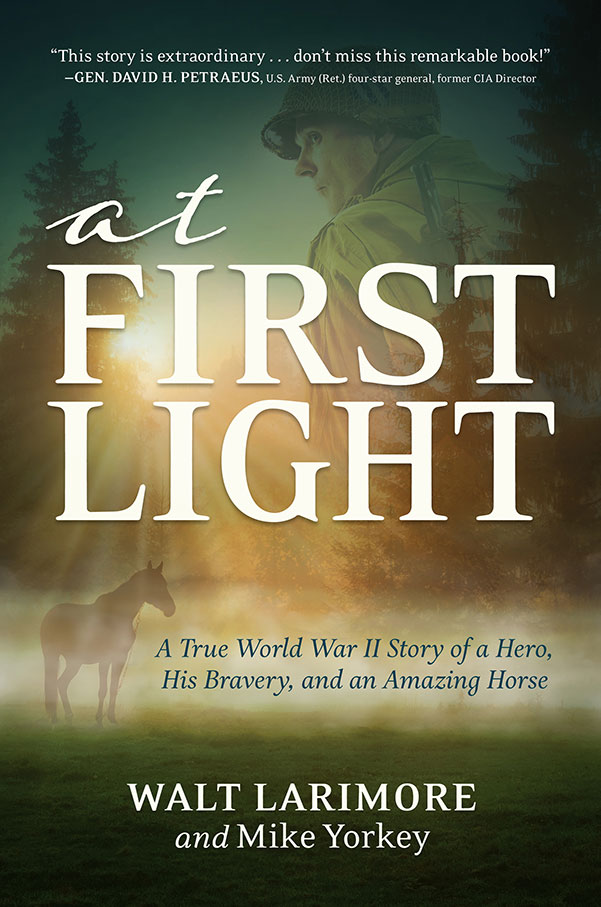
March 15, 1944 – Baptism by fire (Part 1)
March 15, 2024
March 17, 1944 – Dad’s first medal of valor caused Mount Vesuvius to blow her top
March 17, 2024“No soldier in any of our theaters of operations is better acquainted with this war than is the Infantryman, and no Infantryman knows war more intimately than does the front-line rifleman.” — Lieutenant General Ben Lear, Commanding General of the U.S. Second Army from 1940–1943

(continued from yesterday)
Fortunately, the Germans didn’t have time to get established defensively. After a vicious fight in which grenades and close-in fighting were required, the resolute Company L regained House 5. By 0320 hours on March 16, both houses were in American control, but the gains had been costly, as Company L had sustained eighteen casualties, including two officers wounded.
Captain Pridgen, Ross, and Phil immediately began working together to outpost the houses, placing men and guns at strategic points to defend against another counterattack. They set their defensive positions so that their fields of fire would crisscross to the front to prevent further enemy infiltration.
As Phil’s men transported ammunition, wire, and mines to the front, the rears of the houses were demolished by tanks in order for them to take up a safer position inside. A tank firing through a window in a stone house provided significant protection from most enemy anti-tank fire.
Meanwhile, Phil’s platoon was assigned the additional responsibility of improving the positions with barbed wire and hastily laid minefields. Just before dawn, Phil and his A&P Platoon laid fifty-four AP mines[1] in front of Houses 5 and 6, as well as AT mines across the road at the bridge near House 6.
The men accomplished this extensive amount of work in the two hours before dawn, knowing that at the first light of sunrise, any exposed men would be an easy target for German snipers located in well-fortified houses only 100 to 150 yards away. The fact the enemy-held houses were on higher ground made daylight movements even more dangerous due to the enemy’s superior vantage point.
As the sun rose on the cold, crisp morning, Major Bacon and an aide evaded detection and showed up to inspect the houses and congratulate the men on their exceptional work. The major detected a potential problem while looking over the landscape, however. He called Phil to the table where they were meeting. As they sipped their hot coffee, the men looked over a map of the surrounding battlefield.
Phil described what happened next in a letter home to his father:
When the major that commands my battalion was briefing me, he talked to me just like a father. He said he needed an anti-tank minefield in the road. He was afraid the Germans would try to take the houses with tanks. You see, anyone that moves around during daylight hours on the front lines, they shell the heck out of that area instantly.
Well, the major knew I would have to crawl out on the flat open road and would be in plain view of the Jerries only 100 yards away. I said, ‘Yes, sir.’ It was the only thing I could say. A couple of my men and I had to crawl 500 or 600 yards to get additional mines, then crawl back, and then I went out on the road. I laid my field and crawled back in the ditch. About that time, all hell broke loose, but I was on my way back.
German machine gunners and a Panzer IV tank[2] had started shooting at Phil, but he somehow managed to crawl back hurriedly despite shells and machine gun fire shredding the ground around him. Covering fire from the Americans allowed him to stand up and sprint to the safety of House 6. As he dashed back, the men in the foxholes all cheered and whooped for him. Inside the house, Major Bacon and Captain Pridgen gave him congratulatory slaps on his back. “You ought to get a medal!” Pridgen exclaimed.
Ross Calvert hugged him and then poured a healthy swig of scotch that they shared. Phil tried to calm his trembling hands. “When you left,” Ross said, “all I could think was, ‘He’s gonna die!’ Kinda glad you didn’t.”
Phil was unable to quell his still-shaking body. “Me too.”
Ross put his arm around his friend. “Well done, Phil,” he said. “Well done, indeed.”
~~~~~
Phil and the Dogfaces of the 30th did not intend to lose the two houses—and they didn’t. The strong defenses Phil and his men set up around Houses 5 and 6 demonstrated the value of ground on the beachhead. Colonel William Yarborough told his troops:
The price of ground here is skyrocketing, just like the price of Scotch whiskey—high as hell and just as hard to get.
The men of the 30th Infantry learned that to seize beachhead property was one thing—but to hold it was another thing entirely.
[1] Anti-personnel (AP) mines were designed for use against humans, as opposed to anti-tank (AT) mines, which were designed for use against vehicles. Mines were often designed to injure and not kill their victims, in order to increase the medical support required by keep them alive.
[2] The Panzerkampfwagen IV, commonly known as the Panzer IV, was Germany’s most abundant tank and the second-most common German armored fighting vehicle of World War II.
[3] From: At First Light: A True World War II Story of a Hero, His Bravery, and an Amazing Horse, Chapter 17, “Baptism Under Fire.”
In case you haven’t read or listened to Dad’s book, you can learn more or order it here.
© Copyright WLL, INC. 2024.




